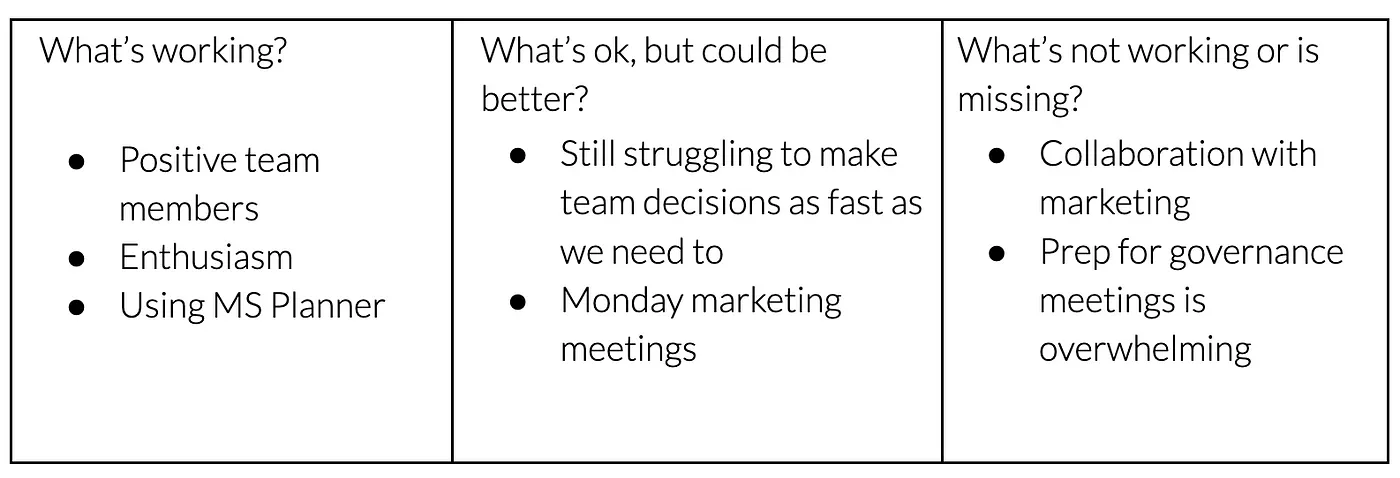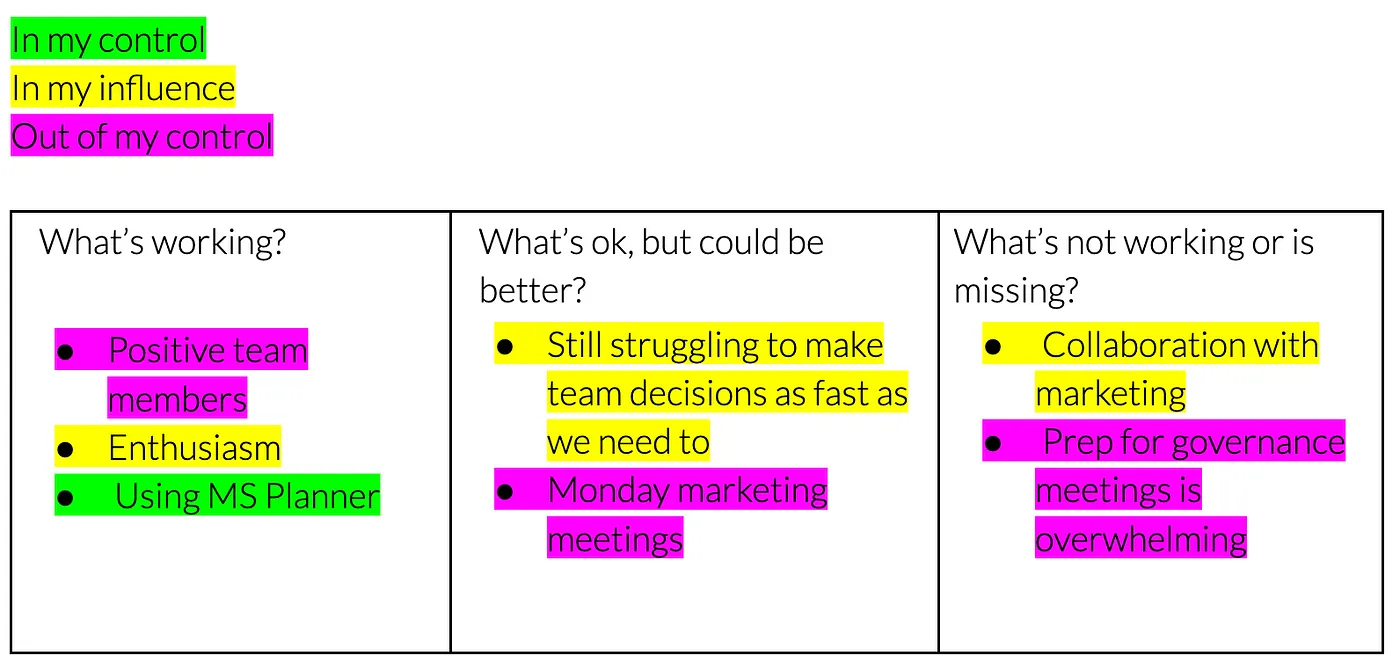Digital Garden of Paul
1:1s
Here’s my take on 1-1s. 1-1s are an investment in the future of your team members: you’re investing in their wellbeing, their capability, and their trust – so that when something happens that they need to tell you about, they will – without having to worry about asking for your time first. 1-1’s are great for handling the stuff that is non-urgent, but most important.
From Psychological Safety 77 (newsletter)
Getting the most out of your 1:1
A format for 1:1s designed and shared by The Ready.
1:1s can be a precious space to build relationships and dig into challenging topics. But many of us don’t realize the potential actually hiding inside the 1:1 format. Most of the time that potential is wasted—on small talk ("How was your weekend?"), surface-level updates ("Yeah, the project is going pretty well"), and venting ("The marketing team just isn't stepping up").
What if instead of using that time to exchange pleasantries or air frustrations, you could beeline to deeper conversations and meaningful insights? And what if that change could happen with minimal effort?
You might be thinking, "A 1:1 is just a conversation. Why would I use something structured just to speak with a colleague? I know how to talk to people." Well, I know how to write. I’ve been writing for most of my life. You know what else? My colleague Zoe, a professional editor, offered feedback on this article. Could I have produced something interesting on my own? Sure. Did this turn out better with help? Yes.
Part I. Reflect (5 minutes)
Context-free, general comments typically eat up valuable time and give us little to work with. Instead, take 5 minutes to have your team member answer these 3 prompts in writing.
What’s working?
What’s ok, but could be better?
What’s not working or is missing?
Why these prompts? Because they nudge people to think across (and to be honest about) all the experiences they’re having. For some, answering these questions helps quiet anxiety about admitting something isn’t working. For others, these prompts help them think about what is working.
Why write answers down? Because it gets you more information in the same or less amount of time. Will you feel weird or uncomfortable sitting silently while your colleague is writing? Probably. But bear with it. Multi-task. Take the bathroom break you’ve needed since your afternoon meeting marathon started. Any upfront awkwardness will be worth it.
How does it actually work? Make a template like the one here in a shared document and ask your team member to type in their answers after a few minutes of small talk. You can also share the template in advance (with the caveat that this isn’t meant to take much prep time). If you work closely with this person, do the same exercise: Consider the prompts and write your answers down. None of us are above learning; reflecting and getting advice is something you’ll benefit from like everyone else.
Sample output from this step.

Part II. Discuss (10–20 minutes)
Most people know how to generally discuss what they see, but they don’t know how to surface what’s behind an answer.
You think a meeting isn’t working. Why do you think it isn’t working?
Partnering with a marketing colleague is challenging. What’s making it harder to partner with that person?
I don’t mean to suggest gossiping about colleagues. Rather, step back and consider what about the way you work—the way you meet, decide, and prioritize—is making work harder. The same goes for the good stuff. If something’s humming, you want to understand why so the magic can be recreated.
The first step in doing this is acknowledging a few important truths.
- Power dynamics are real. You have to create space and make explicit invitations to help people be honest. Even then, it might take several 1:1s for someone to feel safe enough to really go there. That’s normal—and it’s part of your role to acknowledge it.
- Self-disclosure and curiosity are important. Most leaders have been trained to show up as if they know best. But the more you can be honest about your own experience, ask questions with genuine curiosity, and acknowledge the relevant tradeoffs you’re navigating as a leader, the more both of you will get out of the conversation.
- Honesty without judgment is crucial—and hard. People often hold back out of worry for other people’s emotions. Or when they do call something out, they do so with judgment. The trick is to be honest in a way that communicates what you’re seeing (without hedging), but that doesn’t assume your perspective is right and the other person’s is wrong.
Now, let’s jump into prompts (based on real conversations) to dig into the juicy stuff:
- "What do you notice across your answers?"
- "What about the way you/we/they do X, Y, or Z is working well?"
- "Will you say more about item X in 'What’s not working?'"
- "I’m surprised there isn’t anything about Z. Why is that?"
- "All of us tend to play some role in maintaining certain patterns. How might you/we be playing a role in this pattern persisting?"
- "How might the way we meet, make decisions, or collaborate play a role in what’s currently happening?"
Let’s apply these to the example above. Based on the answers, you might ask, "What about the Monday meeting isn’t quite working? Why do you think that is?" or "Without focusing on people for a moment, what about the way we work with marketing might be making our collaboration harder?" Remember, you should share your own honest observations, too!
Part III. Notice Patterns (10–15 minutes)
A lot of leaders want to empower their people but aren’t sure how. We also typically hold a lot of assumptions about empowerment: what it means to each of us and how we understand the current lay of the land.
The next step in this 1:1 format will help you understand how you and your team member view the current state of power—and empowerment—in your team. That understanding can help you support and shift the way your team member shows up, especially where you see things differently.
How do we do that? After discussing the answers, ask your team member to consider which items they have control over, which ones they can influence, and which ones are out of their control. Have them highlight their answers accordingly. You can do the same, adding colors next to theirs where you see things differently.
Sample output from this step.

Next, take a moment to consider the constellation of colors that emerged. Reflect on the following questions together:
- Is there significantly more of one color than another? If so, why?
- Is there a clear difference between colors in the what’s working, what’s ok, and what’s not working categories? If so, why?
- Are there items you disagree on? If so, where exactly does your opinion diverge? What are the actions you disagree on? (Remember, this isn’t about right and wrong. Share facts, ask questions with curiosity, and get specific.)
Consider the example above. Based on the colors you might ask, "Is it true that the quality of the marketing meeting is completely out of your influence? What feedback have we given to our marketing partners?"
For struggling with team decisions on our own team, we might ask, "Are there any aspects of this we can control? We can’t control people, but have we tried a different method of making decisions?"
For governance prep, you might ask, "What could we adjust about the way we collaborate and create governance-related content to reduce work, even if the need for prep can’t go away completely?"
Consider which one or two items are most important to dig into in this particular conversation. You’ll never cover everything in a single 1:1 and that’s OK. Focus on what’s most useful for now.
Part IV. Identify What’s Next (5 minutes)
The last step is taking a moment to consider what this conversation should mean for you and your team member going forward. This might seem obvious, but it’s easy to think we have clarity on next steps only to later realize we’re not so sure.
What does that look like? You and your team member both write down answers to the following questions:
- What does this mean for me going forward? What can I do differently? E.g. Make requests and see how people react instead of assuming they won’t be receptive.
- What requests do I have for others/my partners? What’s my first step? E.g. Propose to marketing that we have a monthly retrospective to tackle challenges and share feedback more regularly. Add it as an agenda item in the next Monday meeting.
Finally, close the 1:1 by having each of you share verbally what you noticed about the dialogue overall. What did you notice? What did you learn?
You, Yourself, and the 1:1
Everything you do as a leader either reinforces or disrupts the patterns around you. If you’ve found yourself wanting more ownership, more empowerment, more innovation—more anything—try using this template on yourself. Consider your own role in reinforcing or disrupting the dynamics around you.
If you’re not willing to try something new in a space that’s as safe as a 1:1, how can you expect others to do so in high-stakes contexts, like meetings with cross-functional partners or senior stakeholders?
If you’re not inviting deep thinking and partnership in 1:1s, how can you expect that to show up in group meetings?
What pattern might trying (or not trying) this new format disrupt or reinforce?
If you’re still hesitant, fight through it. It won’t be perfect on the first try and that’s OK. Just keep trying. That’s how you’ll learn.
References
Psychological Safety 77 (newsletter) \ https://www.linkedin.com/pulse/how-take-your-11s-next-level-the-ready-oek7c/?trackingId=aPfGkbaog9PtU41pngGHdA%3D%3D